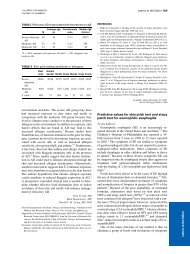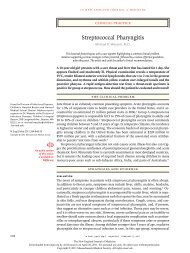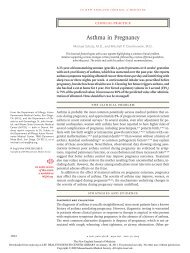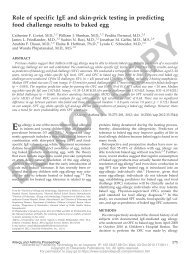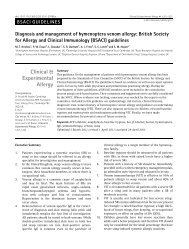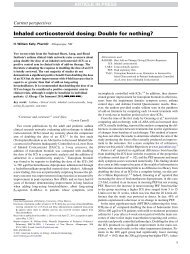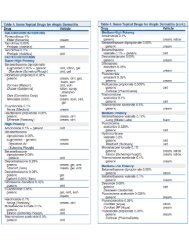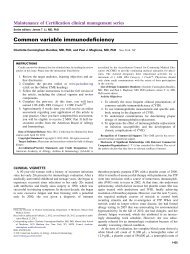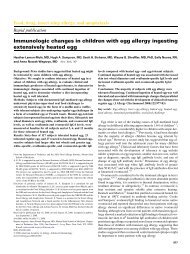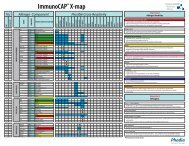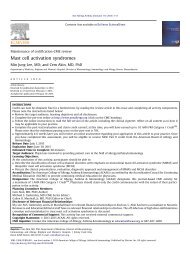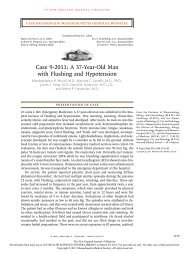Diagnosis and management of oral allergy syndrome ... - AInotes
Diagnosis and management of oral allergy syndrome ... - AInotes
Diagnosis and management of oral allergy syndrome ... - AInotes
Create successful ePaper yourself
Turn your PDF publications into a flip-book with our unique Google optimized e-Paper software.
pollen) <strong>and</strong> be at higher risk for systemic reactions.<br />
Skin testing — Skin testing is the best method <strong>of</strong> demonstrating pollen<br />
sensitization. The performance <strong>and</strong> interpretation <strong>of</strong> skin testing for environmental<br />
allergies is reviewed separately. (See "Overview <strong>of</strong> skin testing for allergic<br />
disease".)<br />
Immunoassays — If skin testing is not available or not possible because the<br />
patient is taking interfering medications or for other reasons, then IgE<br />
immunoassays may be helpful in detecting sensitization to pollens. These are<br />
generally less sensitive than skin tests. (See "Overview <strong>of</strong> skin testing for allergic<br />
disease".)<br />
Oral food challenges — Patients with PFAS will frequently have positive skin or in<br />
vitro tests to several related foods within a plant family, as mentioned above.<br />
However, as in other forms <strong>of</strong> IgE-mediated food <strong>allergy</strong>, positive tests do not<br />
necessarily predict clinical symptoms upon ingestion. Thus, <strong>oral</strong> food challenge<br />
remains the only definitive method <strong>of</strong> identifying clinical reactions.<br />
Although <strong>oral</strong> food challenges are the most conclusive means <strong>of</strong> confirming food<br />
<strong>allergy</strong>, challenges in PFAS may be impacted by some <strong>of</strong> the same issues that<br />
affect skin testing. Allergen levels can vary among cultivars, within different parts<br />
<strong>of</strong> the fruit (peel versus flesh), with ripeness, or due to changes induced by storage<br />
[9]. Challenge studies suggest that a history <strong>of</strong> clinical reactivity can be confirmed<br />
by <strong>oral</strong> food challenges in only one-third <strong>of</strong> melon allergic patients, in two-thirds <strong>of</strong><br />
patients allergic to fruits from Rosaceae family (peach, plum, pear, apple, almond,<br />
apricot, <strong>and</strong> strawberry), <strong>and</strong> in approximately 80 percent <strong>of</strong> patients allergic to<br />
fruits from Prunoideae family (peach, apricot, plum, <strong>and</strong> cherry) [8,10,11].<br />
The importance <strong>of</strong> obtaining a definitive diagnosis depends upon the severity <strong>of</strong> the<br />
reaction, nutritional needs, food preferences, <strong>and</strong> social issues. In many cases, diet<br />
is empirically limited based on the clinical history <strong>and</strong> the results <strong>of</strong> SPTs, rather<br />
than formal food challenges. However, food challenge may be indicated in certain<br />
situations:<br />
In patients with past systemic reactions to mixed foods, when the culprit food<br />
could not be unequivocally identified through skin or in vitro testing. In this<br />
case, the challenge would be performed in order to ascertain that the<br />
responsible food had been correctly identified.<br />
In patients reporting symptoms to a specific food, in whom testing failed to<br />
demonstrate sensitization to that food. Challenge would be done in this<br />
situation because testing may have been falsely negative due to allergen<br />
variability. (See 'Objective testing for food <strong>allergy</strong>' above.)



